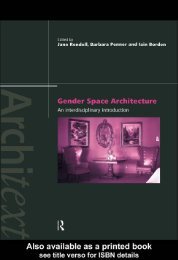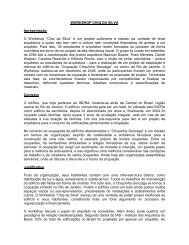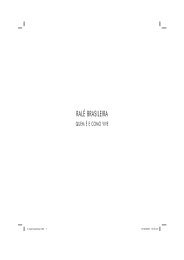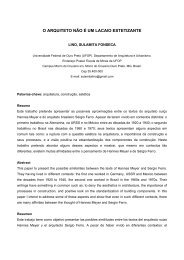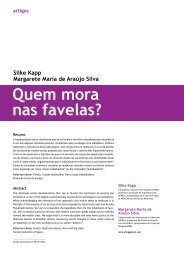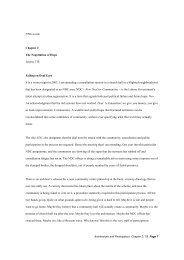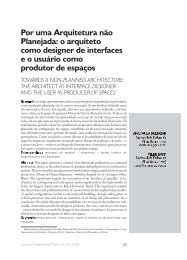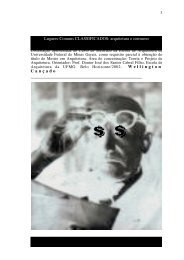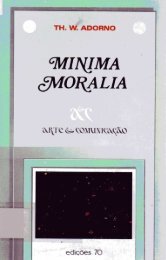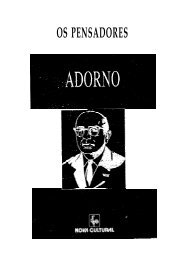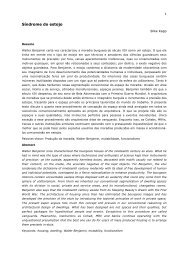Magia além da ignorância: virtualizando a caixa preta
Magia além da ignorância: virtualizando a caixa preta
Magia além da ignorância: virtualizando a caixa preta
Create successful ePaper yourself
Turn your PDF publications into a flip-book with our unique Google optimized e-Paper software.
00<br />
Ensaios<br />
ESSAYS<br />
128<br />
1
00<br />
SUMÁRIO<br />
CONTENTS<br />
7.1<br />
7<br />
Artigos ______4<br />
Articles ______4<br />
PATRÍCIA MORAN<br />
À guisa de introdução ______4<br />
An Introduction ______10<br />
7.6<br />
SÔNIA LABOURIAU<br />
Uma re-flexão lateral: <strong>da</strong> arte<br />
contemporânea para o digital ______113<br />
A lateral reflection: from<br />
contemporary art to the digital ______120<br />
1 Oi Futuro ______ 5<br />
Oi Futuro ______ 6<br />
2 FAD __________ 17<br />
FAD __________ 13<br />
3 FAD 2007 ______ 18<br />
FAD 2007<br />
4 FAD 2009 ______ 43<br />
FAD 2009<br />
5 FAD 2010 _______ 63<br />
FAD 2010<br />
6 Oi Kabum! _______115<br />
Oi Kabum! _______118<br />
7.2<br />
7.7<br />
ANA PAULA BALTAZAR E<br />
JOSÉ DOS SANTOS CABRAL FILHO<br />
<strong>Magia</strong> além <strong>da</strong> ignorância: <strong>virtualizando</strong> a <strong>caixa</strong>-<strong>preta</strong> ______12<br />
Magic beyond ignorance: virtualizing the black box ______19<br />
EDUARDO DE JESUS<br />
Notas diversas: o tempo presente e o local ______58<br />
Various notes: the present time and the local ______66<br />
8<br />
Ficha Técnica ______130<br />
Technical Data ______130<br />
7.3<br />
ROMERO TORI<br />
Códigos digitais e algoritmos como<br />
instrumentos de designers e artistas ______24<br />
Digital codes and algorithms as instruments<br />
for designers and artists ______32<br />
7.4<br />
7.5<br />
7.9<br />
7.8<br />
SANDRO CANAVEZZI<br />
Permeabili<strong>da</strong>des entre homem e máquina digital ______38<br />
Permeabilities between man and digital machine ______51<br />
DANIELA KUTSCHAT<br />
Ensaio para todos e para ninguém ______60<br />
Essay for nobody and for all ______67<br />
PATRÍCIA MORAN<br />
Primeiras notas para uma história <strong>da</strong>s artes<br />
do vídeo ou Entre ruídos e memórias ______74<br />
First notes of a history of video arts<br />
or Between noises and memories ______89<br />
Bios ______124<br />
9<br />
Index ______136<br />
2<br />
3
00<br />
Ana Paula Baltazar e<br />
José dos Santos Cabral Filho<br />
A magia tem longa presença na<br />
história <strong>da</strong> humani<strong>da</strong>de, e<br />
fomos habituados a ver explicações<br />
mágicas como fruto <strong>da</strong><br />
ignorância: na incapaci<strong>da</strong>de de<br />
explicar os fenômenos <strong>da</strong><br />
natureza, os homens primitivos<br />
recorriam a explicações mágicas<br />
– o que chamamos explicações<br />
sobrenaturais – para indicar seu<br />
caráter não científico. Em<br />
contraponto à explicação mágica,<br />
sobrenatural, temos o universo<br />
<strong>da</strong> técnica, que li<strong>da</strong> de<br />
forma racional com os fenômenos<br />
naturais. A mágica trabalharia<br />
com o encantamento<br />
baseado no figurativismo, cujas<br />
relações de causa e efeito dos<br />
processos se dão por correspondência<br />
<strong>da</strong> aparência. Já a<br />
técnica buscaria um desencantamento<br />
<strong>da</strong>s aparências, vendo<br />
os processos de causa e efeito<br />
com fun<strong>da</strong>mentos mecânicos e<br />
matemáticos.<br />
Mas essa oposição entre mágica e<br />
técnica é, na ver<strong>da</strong>de, mais complexa<br />
do que parece, e podemos dizer que<br />
ambas têm objetivos similares:<br />
buscam entender as interconexões<br />
entre os fenômenos <strong>da</strong> natureza e<br />
também interferir no an<strong>da</strong>mento<br />
habitual desses processos; buscam<br />
viabilizar a existência humana em<br />
uma natureza sem significado e, de<br />
alguma forma, inóspita. A magia<br />
buscando mais a significação <strong>da</strong><br />
experiência; a técnica, a resolução de<br />
problemas pragmáticos (a funcionali<strong>da</strong>de<br />
<strong>da</strong> experiência). Em suma,<br />
ambas são formas de li<strong>da</strong>r com nossa<br />
ignorância do mundo. Com o desenvolvimento<br />
tecnológico e o consequente<br />
desencantamento do mundo,<br />
12<br />
13
01<br />
o que nos sobrou do universo <strong>da</strong><br />
magia foi a mágica, em seu sentido<br />
atual de ilusionismo e entretenimento,<br />
que cultivamos como jogo inocente –<br />
como um truque que brinca com o<br />
universo <strong>da</strong>s relações de causa e efeito.<br />
Com o surgimento <strong>da</strong>s tecnologias<br />
digitais, a conexão entre mágica e<br />
tecnologia passa a ser invoca<strong>da</strong> com<br />
muita frequência, devido ao fato de<br />
que a funcionali<strong>da</strong>de dos aparatos<br />
digitais ca<strong>da</strong> vez mais desafia a<br />
compreensão do observador comum,<br />
tanto pela escala minúscula de seus<br />
componentes quanto por sua capaci<strong>da</strong>de<br />
de alterar a percepção espaçotemporal.<br />
Aceleração e compressão<br />
viraram jargões de otimização<br />
tecnológica, acenando com a possibili<strong>da</strong>de<br />
fictícia de apressar o tempo ou<br />
diminuir o espaço, como se detivéssemos<br />
poderes mágicos bem ao estilo<br />
“Harry Potter”. E não é sem razão<br />
que essas tecnologias são chama<strong>da</strong>s<br />
de “novas tecnologias”, já que desafiam<br />
todo o conhecimento <strong>da</strong> já<br />
cita<strong>da</strong> relação de causa e efeito à<br />
qual a técnica tradicional até então<br />
nos havia habituado. Assim, nos<br />
postamos diante destas novas<br />
tecnologias como o homem primitivo<br />
diante do mundo pré-científico: frente<br />
aos processos que não compreendemos,<br />
recorremos à ideia de mágica.<br />
Este cenário de novas e mágicas<br />
tecnologias vai impactar também o<br />
campo <strong>da</strong> arte, com o surgimento <strong>da</strong><br />
chama<strong>da</strong> “arte digital”. A relação<br />
entre mágica e arte é também antiga,<br />
remontando aos exemplos mais<br />
arcaicos <strong>da</strong>s pinturas parietais de<br />
cavernas pré-históricas. Há claras<br />
evidências de que estas eram liga<strong>da</strong>s<br />
a rituais, certamente de magia. De<br />
qualquer forma a arte, desde suas<br />
origens mais remotas, tem como<br />
característica o processo de invenção<br />
e criação que, de alguma maneira,<br />
mimetiza um processo criativo divino<br />
– neste sentido ver<strong>da</strong>deiramente<br />
mágico, capaz de criar um mundo a<br />
partir do na<strong>da</strong>.<br />
Sob essa ótica, a arte digital seria<br />
duplamente mágica: por ser arte e,<br />
portanto, invenção do inexistente, e<br />
por ter como suporte uma técnica de<br />
aspectos mágicos (truque). No entanto,<br />
quando observamos a maioria dos<br />
exemplos de artes digitais, elas estão<br />
menos liga<strong>da</strong>s à magia no sentido<br />
arcaico (a magia <strong>da</strong> experiência) e<br />
mais à mágica como recreação,<br />
basea<strong>da</strong>s no ilusionismo decorrente<br />
<strong>da</strong> ignorância do que é programado.<br />
Mas sabemos que não há mágica no<br />
mundo do programa, apenas uma<br />
certa opaci<strong>da</strong>de de seu funcionamento.<br />
A ignorância do processo programático,<br />
“tecnológico”, pode parecer<br />
mágica no sentido do truque, mas a<br />
magia que nos interessa reside na<br />
fruição, na experiência do espectador.<br />
Um exemplo interessante de como o<br />
truque é irrelevante na elaboração<br />
artística são os quadros de Vermeer,<br />
que até recentemente foram considerados<br />
como uma aplicação <strong>da</strong>s<br />
técnicas de perspectiva, o que seria<br />
bem típico de sua época. No entanto,<br />
Steadman demonstrou que o processo<br />
adotado teria sido na ver<strong>da</strong>de a<br />
câmera escura, o que alguns críticos,<br />
indignados, veem como um truque.<br />
Mas, na ver<strong>da</strong>de, não faz diferença<br />
para a experiência artística o processo<br />
usado por Vermeer. O que interessa é<br />
a delicadeza <strong>da</strong>s cenas cria<strong>da</strong>s pelas<br />
mulheres retrata<strong>da</strong>s em seus afazeres<br />
do cotidiano, ou seja, a magia <strong>da</strong><br />
experiência e não a mágica do truque.<br />
Uma forma de li<strong>da</strong>r com a ignorância<br />
dos processos sem recorrer à ideia de<br />
mágica e sem recorrer ao processo de<br />
desmistificação (retira<strong>da</strong> do mistério)<br />
<strong>da</strong> técnica surgiu mais recentemente<br />
com a adoção do conceito de <strong>caixa</strong><strong>preta</strong><br />
pela Cibernética. Esse conceito,<br />
desenvolvido por Ashby, propõe que<br />
tratemos metaforicamente como<br />
<strong>caixa</strong>-<strong>preta</strong> os fenômenos dos quais<br />
desconhecemos o mecanismo de<br />
funcionamento e que apenas sabemos<br />
o input e o output resultante. É<br />
importante salientar que a <strong>caixa</strong>-<strong>preta</strong><br />
é um constructo conceitual e não um<br />
objeto físico. A despeito disso, muitos<br />
artistas tomam a ideia literalmente e<br />
acabam criando <strong>caixa</strong>s físicas, que,<br />
ain<strong>da</strong> que apresentem algum mecanismo<br />
de interação, seduzem o<br />
espectador pela ignorância dos<br />
mecanismos operativos e não pela<br />
magia <strong>da</strong> experiência.<br />
Se quisermos desenvolver <strong>caixa</strong>s-<strong>preta</strong>s<br />
ver<strong>da</strong>deiramente interativas, que<br />
propiciem a magia <strong>da</strong> experiência (e<br />
não a magia pela ignorância dos<br />
processos), deveremos recorrer ao<br />
virtual que não é o meramente digital.<br />
No lugar do “branqueamento” <strong>da</strong><br />
<strong>caixa</strong>-<strong>preta</strong> (que torna a experiência<br />
previsível e predetermina<strong>da</strong>, pois o<br />
truque é revelado ao espectador ou<br />
usuário, que perde, assim, o interesse<br />
na interação), propomos a discussão<br />
de processos que não sejam<br />
<strong>caixa</strong>s (nem <strong>preta</strong>s nem brancas),<br />
mas interfaces virtuais, eventos-latentes,<br />
com os quais as pessoas possam<br />
se engajar e <strong>da</strong>r continui<strong>da</strong>de nos<br />
designs. Essa seria a virtualização <strong>da</strong><br />
<strong>caixa</strong>-<strong>preta</strong>, partindo <strong>da</strong> abertura do<br />
design aos outros – um design responsável,<br />
como trabalhado por Flusser.<br />
Para Flusser, todo objeto de design<br />
tem por intuito remover um obstáculo<br />
(um problema), e, para isso, cria um<br />
novo obstáculo (objeto). A questão<br />
que se coloca é sobre como ser o<br />
menos obstacularizante possível,<br />
abrindo o design para o Outro.<br />
Entendemos que o virtual aju<strong>da</strong> a<br />
caminhar nessa direção.<br />
O virtual não é sinônimo de digital e<br />
o digital geralmente não é virtual.<br />
Digital é uma tecnologia distinta <strong>da</strong><br />
analógica, basea<strong>da</strong> em inputs de 0 e<br />
1, que pode oferecer uma gama quase<br />
infinita de combinações para interação.<br />
Contudo, o fato de oferecer possibili<strong>da</strong>des<br />
técnicas para interação não<br />
significa ser virtual. Por outro lado, os<br />
trabalhos de Lygia Clark, por exemplo,<br />
oferecem interação analógica e<br />
podem ser considerados virtuais. Tanto<br />
interativi<strong>da</strong>de digital quanto analógica<br />
podem ser classifica<strong>da</strong>s segundo sua<br />
virtuali<strong>da</strong>de, numa escala que varia<br />
de interativi<strong>da</strong>de “não-interativa” a<br />
interativi<strong>da</strong>de “interativa”. Nessa<br />
escala, uma <strong>caixa</strong> de música, por<br />
exemplo, estaria próxima <strong>da</strong> interativi<strong>da</strong>de<br />
“não-interativa”, pois a interação<br />
se dá com a interface e não com<br />
o conteúdo. Acionamos a manivela<br />
(interface) e a música toca<strong>da</strong> (conteúdo)<br />
está totalmente predetermina<strong>da</strong>.<br />
Já o piano, por exemplo, encontra-se<br />
do outro lado <strong>da</strong> escala, próximo <strong>da</strong><br />
interativi<strong>da</strong>de “interativa”, pois<br />
interagimos com o conteúdo através<br />
<strong>da</strong> interface: a música não está<br />
pretedermina<strong>da</strong>, é cria<strong>da</strong> a partir <strong>da</strong><br />
interação com as teclas. Certamente,<br />
uma interface nunca é neutra, já que<br />
seu grau de prescrição afeta a escala<br />
Ana Paula Baltazar e José dos Santos Cabral Filho - <strong>Magia</strong> além <strong>da</strong> Ignorância: Virtualizando a Caixa-Preta.<br />
14 15
Ambiente virtual de<br />
imersão produzido<br />
pelo LAGEAR<br />
usando a espacialização<br />
de imagens<br />
interativas por meio<br />
de gestos<br />
de interativi<strong>da</strong>de, como demonstram<br />
os exemplos acima.<br />
O virtual, que preserva a mágica <strong>da</strong><br />
experiência por engajar o usuário na<br />
criação de situações, sempre opera<br />
com a possibili<strong>da</strong>de de interação não<br />
prescrita (interativi<strong>da</strong>de “interativa”).<br />
A Máscara com Espelhos (1967) de<br />
Lygia Clark, por exemplo, celebra<br />
essa interativi<strong>da</strong>de colocando pequenos<br />
espelhos manipuláveis em frente<br />
dos olhos do usuário, fragmentando e<br />
sobrepondo imagens do entorno às do<br />
próprio usuário. A artista não disponibiliza<br />
um produto pronto e acabado a<br />
ser usado, mas uma interface<br />
analógica que induz e canaliza<br />
experiências únicas. Esse trabalho só<br />
ganha existência efetiva temporariamente,<br />
quando <strong>da</strong> interação do<br />
usuário. No extremo oposto estaria a<br />
chama<strong>da</strong> reali<strong>da</strong>de virtual de imersão,<br />
em que o espectador experimenta<br />
uma simulação, uma reprodução<br />
prescrita a priori, que é sempre digital,<br />
mas dificilmente virtual.<br />
O virtual caracteriza-se, assim, como<br />
um evento latente, ain<strong>da</strong> não manifesto,<br />
e embora seja atualizável pela<br />
interação <strong>da</strong>s pessoas com uma<br />
interface, tal interação não é prescrita<br />
na interface. Recorrendo a Heidegger,<br />
podemos dizer que o virtual difere<br />
de uma pedra que está “presente à<br />
mão”, e, embora tenha proprie<strong>da</strong>des,<br />
não tem atributos; difere, ain<strong>da</strong>, de<br />
um martelo, que está “pronto à<br />
mão”, com proprie<strong>da</strong>des e atributos<br />
previamente definidos. O virtual<br />
extrapola essas categorias de Heidegger<br />
e aponta para o que podemos<br />
chamar de “aberto à mão”, cujos<br />
atributos são temporariamente<br />
definidos pelos usuários durante a<br />
interação. Embora as proprie<strong>da</strong>des de<br />
uma interface (sua substância potencial<br />
ou real, para usar os termos de<br />
Lévy) sempre limitem suas possibili<strong>da</strong>des<br />
de atualização, para que seja<br />
de fato virtual, esse limite deve ser o<br />
menor possível, <strong>da</strong>ndo priori<strong>da</strong>de ao<br />
evento, à experiência não prescrita na<br />
elaboração <strong>da</strong> interface.<br />
Todo design leva o evento em<br />
consideração, ain<strong>da</strong> que na maioria<br />
<strong>da</strong>s vezes busque apenas antecipar<br />
e cristalizar as possibili<strong>da</strong>des de<br />
uso ou fruição. Um objeto ou interface<br />
virtual, ao contrário, considera o<br />
evento em seu estado latente e não<br />
prescritivo. A Máscara com Espelhos,<br />
por exemplo, não tem atributos<br />
prévios ao seu uso. Obviamente,<br />
a artista não criou uma interface<br />
neutra, totalmente desprovi<strong>da</strong> de<br />
intenção. Contudo, a intenção <strong>da</strong><br />
artista, ou atributo prévio, não diz<br />
respeito à prescrição do evento,<br />
mas à abertura de novas possibili<strong>da</strong>des<br />
de percepção de seus usuários,<br />
configurando-se assim como um<br />
evento-latente (virtual e atualizável),<br />
e não como um objeto meramente<br />
baseado na substância (potencial<br />
ou real).<br />
Assim, a consideração do evento em<br />
seu estado latente, ou seja, sem<br />
prescrever os atributos que resultarão<br />
<strong>da</strong> interação <strong>da</strong>s pessoas, é fun<strong>da</strong>mental<br />
para a elaboração de interfaces<br />
virtuais. Isso, contudo, não tem<br />
sido o foco do desenvolvimento <strong>da</strong><br />
arte digital em geral, que, apesar de<br />
resultar em inúmeros produtos para<br />
interação do usuário, acaba prescrevendo<br />
tal interação. Isso acontece<br />
tanto nos objetos e imagens digitais<br />
que respondem de forma predetermina<strong>da</strong><br />
à interação dos usuários, quanto<br />
nas artes generativas, em que o<br />
usuário desencadeia um processo<br />
pré-programado, do qual não tem<br />
consciência nem controle, gerando<br />
um produto que, ain<strong>da</strong> que dinâmico,<br />
não é virtual por não propiciar uma<br />
experiência mágica, apenas o fascínio<br />
devido à ignorância do processo. Em<br />
suma, uma <strong>da</strong>s formas de usufruir do<br />
que há de melhor <strong>da</strong> mágica, que é a<br />
magia <strong>da</strong> experiência, seria a virtualização<br />
<strong>da</strong> <strong>caixa</strong>-<strong>preta</strong>, ou seja, sua<br />
transformação em uma ver<strong>da</strong>deira<br />
interface aberta ao Outro.<br />
Referências<br />
Bibliográficas:<br />
Baltazar dos Santos, A. P. (2007).<br />
Towards a virtual architecture: the<br />
mobility of essences and the ‘open in<br />
hand’ in the production-consumption<br />
of spaces, Proceedings of the<br />
International Conference Architecture<br />
and Phenomenology. Israel: Haifa.<br />
Flusser, V. (1999). Design: obstacle<br />
for/to the removal of obstacles. in:<br />
Flusser, V. (Ed.), The shape of things:<br />
a philosophy of design. London:<br />
Reaktion. pp. 58–61.<br />
Nota<br />
Estas discussões<br />
têm informado as<br />
pesquisas e<br />
trabalhos que temos<br />
elaborado no<br />
LAGEAR (Laboratório<br />
Gráfico para<br />
Experimentação<br />
Arquitetônica /<br />
UFMG):<br />
www.arq.ufmg.br/<br />
lagear<br />
Ana Paula Baltazar e José dos Santos Cabral Filho - <strong>Magia</strong> além <strong>da</strong> Ignorância: Virtualizando a Caixa-Preta.<br />
16 17
01<br />
Glanville, R. (s.d.), “Second order<br />
cybernetics”, .<br />
Heidegger, M. (1995). Being and<br />
time. Oxford: Blackwell.<br />
Leakey, R. (1994). The origin of<br />
humankind. London: Wedienfeld &<br />
Nicolson.<br />
Lévy, P. (1996). O que é o virtual São<br />
Paulo: Ed. 34.<br />
Osthoff, S. (1997). “Lygia Clark and<br />
Hélio Oiticica: a legacy of interactivity<br />
and participation for a telematic<br />
future”. In: Leonardo: journal for the<br />
international society for the arts,<br />
sciences and technology. Cambridge:<br />
MIT Press. Vol. 30, No. 4, August, pp.<br />
279–89. .<br />
Steadman, P. (2002). Vermeer’s<br />
camera: uncovering the truth behind<br />
the masterpieces. Oxford: Oxford<br />
University Press.<br />
Thomas, K. (1971). Religion and the<br />
decline of magic: studies in popular<br />
beliefs in sixteenth and seventeenth<br />
century England. London: Penguin.<br />
Ana Paula Baltazar and<br />
José dos Santos<br />
Cabral Filho<br />
Magic beyond<br />
ignorance:<br />
virtualizing<br />
the black box.<br />
Magic has been present in<br />
human history for a long time<br />
and we developed the habit of<br />
seeing magical explanations as<br />
a result of ignorance: unable to<br />
explain the natural phenomenon<br />
the primitive men used magical<br />
explanations, what we call<br />
supernatural explanations, in<br />
order to indicate its nonscientific<br />
character. Contrary to<br />
the supernatural magical<br />
explanation, there is the realm<br />
of technique that deals with the<br />
natural phenomenon in a<br />
rational way. Magic would work<br />
with enchantment based on<br />
figurative expressions whose<br />
relationships of cause and effect<br />
of the processes are done by<br />
equivalence to appearance. On<br />
the other hand, technique would<br />
search for a disenchantment of<br />
the appearances, regarding the<br />
processes of cause and effect<br />
based on mechanical and<br />
mathematical principles.<br />
This opposition between magic and<br />
technique is in fact more complex than<br />
it seems and we can say that both have<br />
similar goals: they try to understand<br />
the interrelationships among the<br />
natural phenomena and also interfere<br />
with these ongoing processes; they try<br />
to make life possible in a meaningless<br />
and inhospitable nature where magic<br />
searches for the meaning of the<br />
experience and technique searches<br />
for the solution of practical problems<br />
(experience made functional). In short,<br />
both are ways of dealing with our<br />
ignorance of the world. With the<br />
technological development and the<br />
consequent disenchantment of the<br />
world, what remained of the realm of<br />
magic was its current sense of<br />
illusionism and entertainment that we<br />
cultivate as an innocent game; as a<br />
trick that plays with the realm of<br />
cause and effect relationships.<br />
With the emergence of digital<br />
technologies, the link between magic<br />
and technology is frequently claimed<br />
due to the fact that the functional<br />
character of digital apparatus challenges<br />
the understanding of ordinary observers<br />
either because of their tiny components<br />
or because of their power to change<br />
the space-time perception. Acceleration<br />
and compression turned to be jargons<br />
of technological optimization, tempting<br />
us with the false possibility of<br />
accelerating time or diminishing space,<br />
as if we had the same magical powers<br />
of a Harry Potter. Not unreasonably<br />
are those technologies called “new<br />
technologies”, for they defy our<br />
knowledge of space and time as we<br />
were used to by traditional technique.<br />
So, we position ourselves in the face<br />
of these technologies just like the<br />
primitive men were in the face of<br />
pre-scientific world: when confronted<br />
with processes that we do not<br />
understand, we turn to the idea of<br />
magic.<br />
Ana Paula Baltazar e José dos Santos Cabral Filho - <strong>Magia</strong> além <strong>da</strong> Ignorância: Virtualizando a Caixa-Preta.<br />
18 19
01<br />
This scenario of new and magical<br />
technologies will also influence the<br />
arts with what we call “digital art”.<br />
The relationship between art and<br />
magic is an old one coming from the<br />
ancient examples of Parietal paintings<br />
on prehistoric caves. There are clear<br />
evidences that they were connected<br />
to rituals, most probably magical<br />
ones. Anyway, art since its remote<br />
origins features the invention and the<br />
creation process that in a way reflects<br />
a divine creative process, truly<br />
magical in this sense, capable of<br />
creating a world out of nothing.<br />
Seen through this viewpoint digital<br />
art would be magical in double: first<br />
because it is art, thus being the<br />
invention of the non-existent;<br />
secondly because it is supported by a<br />
technique that has magical aspects<br />
(tricks). Nevertheless, when we<br />
observe the majority of digital art<br />
examples they are less connected to<br />
magic in the old sense (the magic of<br />
experience) and more to magic as a<br />
playful thing, based on illusionism<br />
which is a result of the ignorance of<br />
what has been programmed. But we<br />
know that there is no magic in the<br />
world of programming, only a certain<br />
blur related to the way it works. The<br />
ignorance about this programming<br />
process, so called “technological”,<br />
may seem as magic in the sense of<br />
trick, but the magic that interests us<br />
is in the enjoyment, in the experience<br />
of the viewer.<br />
The paintings of Vermeer are an<br />
interesting example of how trick is<br />
irrelevant to artistic creation. Until<br />
very recently they were considered as<br />
the application of perspective<br />
techniques, something typical of the<br />
time. However, Steadman has shown<br />
that the process used was in fact the<br />
<strong>da</strong>rk camera, which some critics saw<br />
with indignation as a trick. In fact,<br />
the process that Vermeer used does<br />
not make any difference to the artistic<br />
experience. What counts is the<br />
delicacy of the scenes created by the<br />
women depictured in their every<strong>da</strong>y<br />
chores, that is, the magic of the<br />
experience, not the magic of the trick.<br />
A way of dealing with the ignorance<br />
of the processes without referring to<br />
the idea of magic or to the process of<br />
demystification of the technique<br />
(withdrawal of the mystery), has<br />
recently appeared with the concept of<br />
black box by Cybernetics. This concept,<br />
which was developed by Ashby,<br />
proposes a metaphorical treatment of<br />
the phenomena whose working<br />
mechanisms are unknown to us, and<br />
of which we only know the resulting<br />
input and output, as a black box. It is<br />
important to highlight that the black<br />
box is a conceptual construct and not<br />
a physical object. In spite of this, lots<br />
of artists take the idea literally and<br />
end up creating physical boxes that,<br />
although they have a kind of interaction<br />
mechanism, seduce the viewer by the<br />
ignorance of the way the mechanism<br />
operates and not because of the<br />
magic of the experience.<br />
If we want to develop really interactive<br />
black boxes that create the magic of<br />
experience (and not the magic of the<br />
ignorance of the processes) we must<br />
refer to the virtual that is not merely<br />
digital. Instead of “whitening” the<br />
black box (which makes experience<br />
predictable and predetermined, for<br />
the trick is revealed to the viewer or<br />
user who lose interest in the<br />
interaction), we propose the<br />
discussion of the processes that are<br />
not boxes (neither black nor white),<br />
but virtual interfaces, latent-events,<br />
with which people could engage and<br />
continue the designs. This would be<br />
the black box made virtual, departing<br />
from opening the design to others, a<br />
responsible design, as the one<br />
developed by Flusser.<br />
To Flusser every design object is<br />
meant to remove an obstacle (a<br />
problem), and in order to do this<br />
creates another obstacle (object).<br />
The issue that imposes itself is how<br />
to be as less hindering as possible,<br />
opening the design for the other.<br />
We think that the virtual helps going<br />
in this direction.<br />
Generally speaking, the virtual is not<br />
a synonym for digital and the digital<br />
is not virtual. Digital is a technology<br />
different from the analog, based on<br />
inputs of 0 and 1 that could offer<br />
almost infinite types of combination<br />
for interaction. However, the fact that<br />
it provides technical possibilities for<br />
interaction does not mean it is virtual.<br />
On the other hand, the works by Lygia<br />
Clark, for example, offer analog<br />
interaction and can be considered<br />
virtual. Both digital and analog<br />
interaction can be ranked according<br />
to its virtuality in a scale that goes<br />
from “non-interactive” interactivity to<br />
“interactive” interactivity. According<br />
to this scale, a music box, for example,<br />
would be close to non-interactive<br />
interactivity because the interaction<br />
is with the interface not the content.<br />
We wind the crank (interface) and the<br />
music that plays (content) is completely<br />
predetermined. The piano, for<br />
example, is on the other side of the<br />
scale, close to the “interactive<br />
interactivity”, for we interact with the<br />
content through the interface: the<br />
music is not predetermined but is<br />
created from the interaction with the<br />
keys. Obviously, an interface is never<br />
neutral, since its level of prescription<br />
affects the interactivity scale, as the<br />
examples above demonstrate.<br />
The virtual, that preserves the magic<br />
of the experience by engaging the<br />
user in the creation of new situations,<br />
always operates with the possibility<br />
of non-prescribed interaction<br />
(“interactive” interactivity). The<br />
Mask with Mirrors (Máscara com<br />
Espelhos) by Lygia Clark (1967), for<br />
example, promotes this interactivity<br />
by placing small mirrors that could<br />
be manipulated in front of the eyes<br />
of the viewer, breaking images into<br />
fragments and superimposing these<br />
images of the surroundings on the<br />
ones of the viewer himself. The<br />
artist does not provide a finished<br />
product, ready to be used, but an<br />
analog interface that leads to unique<br />
experiences. This kind of artwork<br />
only exists temporarily, when<br />
interacting with the user. On the<br />
opposite side would be the so called<br />
virtual reality of immersion, where<br />
the viewer experiences a simulation,<br />
a prescribed reproduction that is<br />
always digital but not often virtual.<br />
Therefore, the virtual is a latent<br />
event, not already manifested, and<br />
though it could be up<strong>da</strong>ted by the<br />
interaction of the people with an<br />
interface, this interaction is not<br />
prescribed in the interface. Referring<br />
to Heidegger, we could say that the<br />
virtual differs from a stone because<br />
it is close to the hand, and although<br />
Ana Paula Baltazar and José dos Santos Cabral Filho - Magic Beyond Ignorance: Virtualizing the Black Box.<br />
20 21
01<br />
it has special qualities it does not<br />
have attributes, and it is also different<br />
from a hammer that is ready to use<br />
with special qualities and attributes<br />
that have already been defined. The<br />
virtual goes beyond these Heidegger<br />
categories and points to something<br />
that we could call “open to the hand”<br />
whose attributes are temporarily<br />
defined by users during the interaction.<br />
Although the special qualities of an<br />
interface (its potential or real essence,<br />
using Lévy’s terminology) always put<br />
limits to their possibilities of up<strong>da</strong>ting,<br />
these limits should be as small as<br />
possible to be considered really<br />
virtual, prioritizing the event, the<br />
non-prescribed experience in the<br />
making of the interface.<br />
Every design takes the event into<br />
consideration, even though it<br />
frequently tries only to anticipate and<br />
settle the possibilities of use or<br />
enjoyment. On the contrary, an object<br />
or virtual interface considers the<br />
event in its latent and non-prescriptive<br />
state. The Mask with Mirrors, for<br />
example, does not have prior attributes<br />
to its use. Obviously, the artist has<br />
not created a neutral interface, totally<br />
devoid of intention. Yet, the artist’s<br />
intention, or prior attribute, does not<br />
refer to the prescription of the event,<br />
but to the opening to new possibilities<br />
of perspectives from its users, so<br />
being a latent-event (virtual and due<br />
to up<strong>da</strong>ting) and not a simple object<br />
based on essence (potential or real).<br />
So, to consider the event in its latent<br />
state, that is, without prescribing the<br />
attributes that will be the results of<br />
people interaction, is paramount to<br />
the making of virtual interfaces.<br />
However, this has not been the focus<br />
of the development of digital art in<br />
general, for although it results in a<br />
great number of products to the<br />
interaction of the user, it ends up<br />
prescribing this interaction. This<br />
happens on both objects and digital<br />
images that responds in a<br />
predetermined way to the user<br />
interaction, and in the generative<br />
arts, where the user starts a preprogrammed<br />
process of which he<br />
has neither conscience nor control,<br />
engendering a product which, though<br />
dynamic, is not virtual, for it does<br />
not favor a magical experience, but<br />
only a kind of fascination owing to<br />
the ignorance of the process. In<br />
short, one of the ways of enjoying<br />
the best of magic which is the magic<br />
of the experience would be the<br />
virtualization of the magic box, that<br />
is, the changing of it into a true<br />
interface open to the Other.<br />
Selected Bibliography:<br />
Baltazar dos Santos, A. P. (2007).<br />
Towards a virtual architecture: the<br />
mobility of essences and the ‘open in<br />
hand’ in the production-consumption<br />
of spaces, Proceedings of the<br />
International Conference Architecture<br />
and Phenomenology. Israel: Haifa.<br />
Flusser, V. (1999). Design: obstacle<br />
for/to the removal of obstacles. in:<br />
Flusser, V. (Ed.), The shape of things:<br />
a philosophy of design. London:<br />
Reaktion. pp. 58–61.<br />
Glanville, R. (s.d.), “Second order<br />
cybernetics”, .<br />
Heidegger, M. (1995). Being and<br />
time. Oxford: Blackwell.<br />
Leakey, R. (1994). The origin of<br />
humankind. London: Wedienfeld &<br />
Nicolson.<br />
Lévy, P. (1996). O que é o virtual São<br />
Paulo: Ed. 34.<br />
Osthoff, S. (1997). “Lygia Clark and<br />
Hélio Oiticica: a legacy of interactivity<br />
and participation for a telematic<br />
future”. In: Leonardo: journal for the<br />
international society for the arts,<br />
sciences and technology. Cambridge:<br />
MIT Press. Vol. 30, No. 4, August, pp.<br />
279–89. .<br />
Steadman, P. (2002). Vermeer’s<br />
camera: uncovering the truth behind<br />
the masterpieces. Oxford: Oxford<br />
University Press.<br />
Thomas, K. (1971). Religion and the<br />
decline of magic: studies in popular<br />
beliefs in sixteenth and seventeenth<br />
century England. London: Penguin.<br />
Ana Paula Baltazar and José dos Santos Cabral Filho - Magic Beyond Ignorance: Virtualizing the Black Box.<br />
22 23
BIOS<br />
Ana Paula Baltazar é arquiteta,<br />
doutora em arquitetura e ambientes<br />
virtuais pela University College<br />
London e professora <strong>da</strong> Escola de<br />
Arquitetura <strong>da</strong> UFMG. Desenvolve<br />
pesquisas junto ao LAGEAR e MOM<br />
em interfaces físicas, digitais e<br />
híbri<strong>da</strong>s, e em ambientes de imersão<br />
estereoscópicos. Seu interesse mais<br />
recente está na execução Museu-<br />
Tempo, conectando espaços-eventos<br />
em tempo real.<br />
Ana Paula Baltazar is an architect,<br />
with a doctorate degree on architecture<br />
and virtual environments at the<br />
University College London, and<br />
professor at UFMG Architecture<br />
School. Together with LAGEAR and<br />
MOM, she develops a research program<br />
on physical, digital and hybrid<br />
interfaces, and on stereoscopic<br />
immersion environments. Her latest<br />
interest is in implementing the<br />
Museu-Tempo project, which connects<br />
places and events in real time<br />
José Cabral Filho é graduado em<br />
Arquitetura e Urbanismo pela UFMG.<br />
Mestre em Architectural Studies -<br />
University of Sheffield e doutor em<br />
Architectural Studies - University of<br />
Sheffield com pós-doutorado pela<br />
McGill University (Montreal). Professor<br />
<strong>da</strong> UFMG, Cabral é membro do<br />
corpo editorial de Chora: Intervals in<br />
the Philosophy of Architecture. Atua,<br />
principalmente, com arquitetura e<br />
novas tecnologias.<br />
José Cabral Filho has a graduation<br />
degree on Architecture and Urbanism<br />
at UFMG. He is a master and doctor<br />
on Architectural Studies (University<br />
of Sheffield), with a postdoctoral<br />
degree at the McGill University<br />
(Montreal). Professor at UFMG, he is<br />
also a member of the editorial board<br />
of Chora: Intervals in the Philosophy<br />
of Architecture. He works mainly with<br />
new technologies and architecture.<br />
Eduardo de Jesus é graduado<br />
em Comunicação Social pela PUC de<br />
Minas Gerais. Em 2003, foi aprovado<br />
para uma bolsa de pós-graduação<br />
em curadoria e arte contemporânea<br />
pelo MECAD, em Barcelona onde<br />
realizou a pesquisa: “Desenvolvimento<br />
de arte e mídia na África, Ásia e<br />
América Latina”. Eduardo é Mestre<br />
em Comunicação Social pela UFMG e<br />
doutor Artes Visuais pela USP.<br />
Eduardo de Jesus has a graduation<br />
degree on Social Communication<br />
at PUC Minas. Selected for a curating<br />
and contemporary art post-graduation<br />
scholarship at MECAD (Barcelona) in<br />
2003, where he developed the<br />
research “Desenvolvimento de arte e<br />
mídia na África, Ásia e América<br />
Latina” [Development of media art in<br />
Africa, Asia and Latin America]. He is<br />
a master on Social Communication at<br />
UFMG, and a doctor on Visual Arts at<br />
USP.<br />
01<br />
124 125
01<br />
Sandro Canavezzi é graduado na<br />
Escola de Arquitetura e Urbanismo<br />
<strong>da</strong> EESC-USP. Mestre em Artes pela<br />
Universi<strong>da</strong>de de São Paulo (2000).<br />
Fez especialização em Generative<br />
Systems (T.I.) no Codelab_Berlim, na<br />
Alemanha, de 2001 a 2003. Em<br />
2004, foi artista residente no V2_<br />
Org, em Roterdã. Tem experiência na<br />
área de Artes, com ênfase em arte<br />
eletrônica interativa.<br />
Sandro Canavezzi graduated at<br />
the Architecture and Urbanism<br />
School, ECC/USP. He has a master<br />
degree on Arts at USP (2000). He is<br />
specialized in Generative Systems<br />
(T.I.) at Codelab_Berlim, Germany<br />
(2001-2003). He was a resident<br />
artist at V2_ Org, in Rotter<strong>da</strong>m<br />
(2004). He has experience on arts,<br />
with emphasis on interactive<br />
electronic art.<br />
Patricia Moran é Mestre em<br />
Comunicação Social pela UFRJ e<br />
doutora em Comunicação e Semiótica<br />
pela PUC - São Paulo. Diretora de<br />
diversos curtas-metragem já foi<br />
agracia<strong>da</strong> com prêmios no Brasil e no<br />
exterior. Acaba de estrear seu<br />
primeiro longa-metragem Ponto Org.<br />
Desenvolve pesquisa acadêmica<br />
sobre projeções audiovisuais intitula<strong>da</strong>:<br />
A metáfora dos sentidos. Professora<br />
do Curso Superior do Audiovisual<br />
na ECA-USP.<br />
Patricia Moran is a master in<br />
Social Communication at UFMG, and<br />
holds a doctorate degree in<br />
Communication and Semiotics at<br />
PUC/SP. She is a director of several<br />
short films, and she has been awarded<br />
prizes in Brazil and abroad. She has<br />
just premiered his first feature film,<br />
Ponto Org. She develops an academic<br />
research on audiovisual projections,<br />
called “A metáfora dos sentidos”<br />
[The senses metaphor]. She is a<br />
professor in the audiovisual course at<br />
ECA/USP.<br />
Sonia Labouriau é artista,<br />
performer, videomaker, curadora e<br />
designer. Dedica-se também à<br />
pesquisa e ao ensino. Além de atuar<br />
no circuito <strong>da</strong> arte e interfaces com<br />
outras ativi<strong>da</strong>des, escreve sobre os<br />
campos em que trabalha. Utiliza<br />
diversas formas de interativi<strong>da</strong>de,<br />
analógicas e digitais, com ênfase no<br />
campo <strong>da</strong> escultura, do desenho, <strong>da</strong><br />
gráfica, do vídeo e meios digitais em<br />
campo estrito e/ou expandidos para a<br />
instalação, intervenção urbana,<br />
operações na percepção e no espaço<br />
relacional, além de investigar outros<br />
meios experimentais.<br />
Sonia Labouriau is an artist,<br />
performer, video artist, curator, and<br />
designer. She is also dedicated to<br />
research and teaching. She works on<br />
the art circuit and interfaces with<br />
other activities, and writes about<br />
those fields. She uses several forms<br />
of digital and analog interactivity,<br />
with emphasis in sculpture, drawing,<br />
graphics, video and digital media in<br />
strict or expanded field for installation,<br />
urban intervention, operations in<br />
perception and relationship spaces,<br />
as well as investigating other<br />
experimental ways.<br />
126 127
01<br />
Daniela Kutschat é artista<br />
plástica. Doutora em Artes pela<br />
Universi<strong>da</strong>de de São Paulo, atualmente,<br />
é professora <strong>da</strong> FAU-USP e<br />
do Centro Universitário Senac.<br />
Desenvolve pesquisa e proposições<br />
sensoriais e cognitivas a partir do<br />
duplo Corpo/Espaço e investiga a<br />
aplicação de Tecnologias de Informação<br />
e de Comunicação ao Corpo,<br />
Objeto, Ambiente e Ci<strong>da</strong>de. Participa<br />
de exposições, congressos e de júris<br />
nacionais e internacionais relacionados<br />
à Arte e Cultura Digital.<br />
Romero Tori is an engineer,<br />
doctor, and senior professor at USP.<br />
He coordinates the Interlab Interactive<br />
Technologies Laboratory at POLI/<br />
PCS-USP. He is professor of the<br />
Design masters course at Centro<br />
Universitário SENAC, and of the<br />
Electrical Engineering post-graduate<br />
program at POLI-USP. He organized<br />
several scientific meetings, including<br />
SVR 2004 (Symposium on Virtual<br />
and Augmented Reality), Program Chair<br />
at SVR 2007 and SBGames 2005,<br />
General Vice-Chair at SVR 2008.<br />
Daniela Kutschat is an artist,<br />
with a doctorate degree in arts at USP.<br />
She currently teaches at FAU/USP<br />
and Centro Universitário SENAC. She<br />
is a researcher, and develops sensorial<br />
and cognitive propositions from the<br />
body/space double. She investigates<br />
the application of information and<br />
communication technology to the body,<br />
object, environment, and city. She<br />
participates in exhibitions, conferences,<br />
and national and international juries<br />
related to art and digital culture.<br />
Romero Tori é engenheiro, doutor<br />
e livre-docente pela USP. Coordena o<br />
Interlab Interactive Technologies<br />
Laboratory <strong>da</strong> POLI/PCS-USP.<br />
Professor permanente do Mestrado<br />
em Design do Centro Universitário<br />
Senac e do Programa de Pós-graduação<br />
em Engenharia Elétrica <strong>da</strong><br />
POLI-USP, organizou diversos eventos<br />
científicos, entre eles SVR 2004<br />
(Symposium on Virtual and Augmented<br />
Reality), Program Chair do SVR<br />
2007 e do SBGames 2005, General<br />
Vice-chair do SVR 2008.<br />
128 129
00<br />
ISBN 978-85-61659-19-6<br />
1. Arte eletrônica 2.Cultural digital 3. Festival de Arte Digital 4.Multimídia<br />
interativa<br />
5. Objetos de arte - Exposições - Catálogos I. Roscoe Henrique. II. Moran,<br />
Patrícia. III. Mucelli, Tadeus. Título: FAD - Festival de Arte Digital - 2010<br />
Índice para catálogo sistemático:<br />
1. Cultura digital na arte 700.285<br />
2. Linguagem eletrônica na arte 700.285<br />
APOIO CULTURAL<br />
564/2009<br />
CA 0243/001/2009<br />
CO-PATROCÍNIO<br />
PATROCÍNIO<br />
144<br />
145



